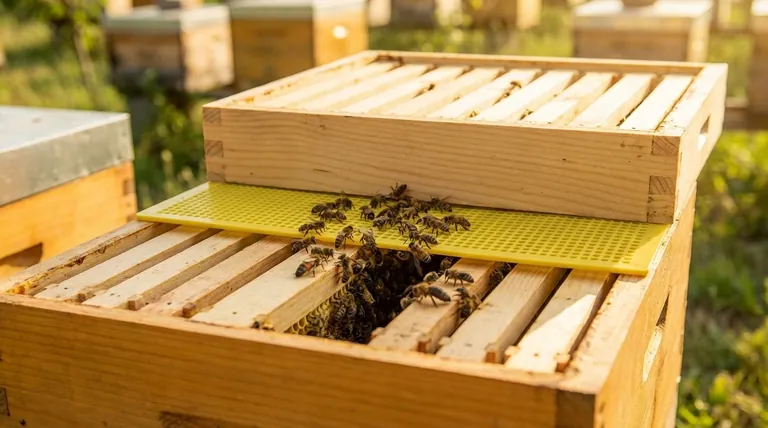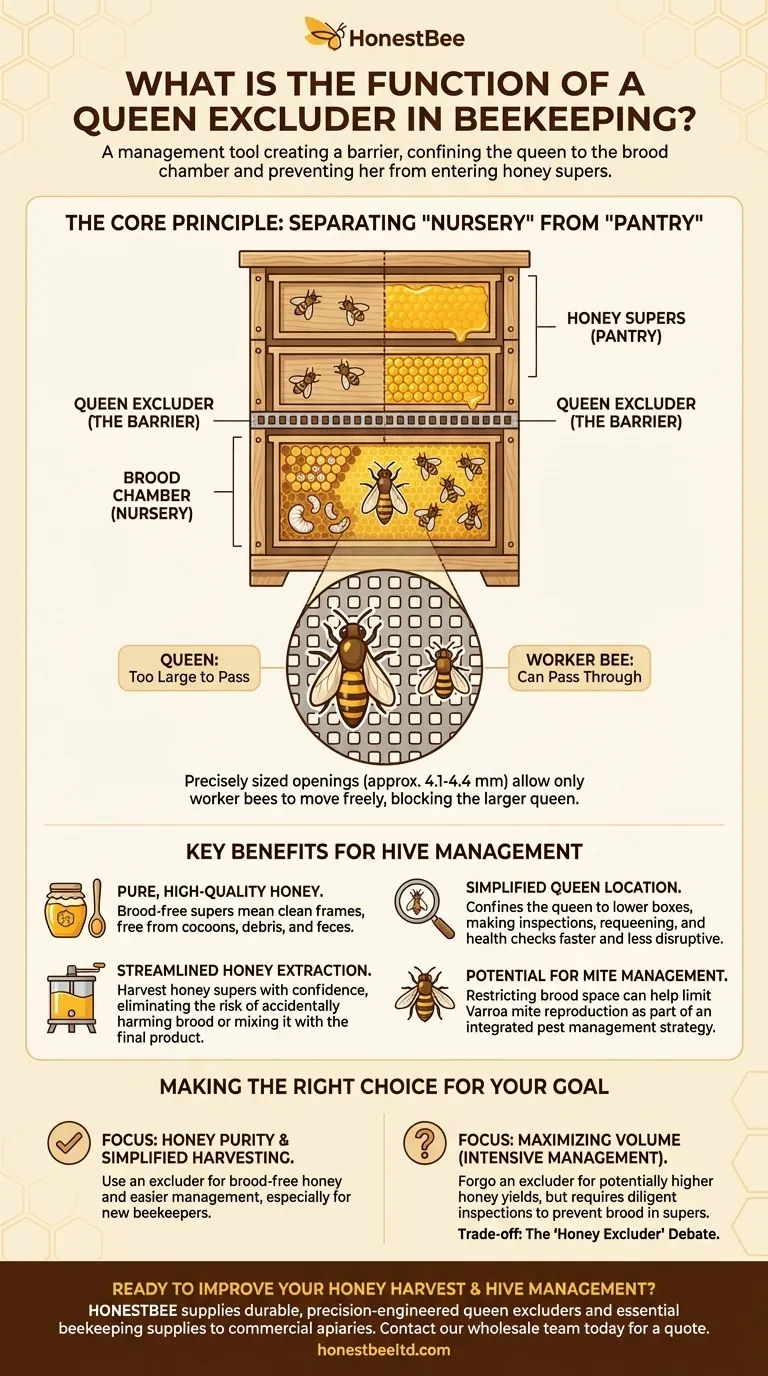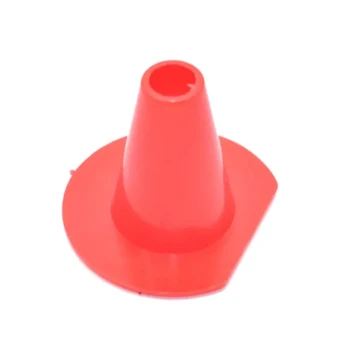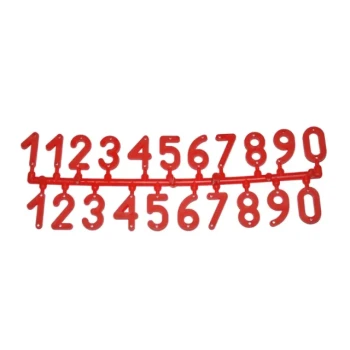A queen excluder is a management tool that creates a barrier within the beehive that only worker bees can pass through. Its primary function is to confine the larger queen bee to a specific area of the hive—typically the lower boxes, known as the brood chamber—preventing her from laying eggs in the upper boxes, or honey supers.
The core function of a queen excluder is to separate the hive's "nursery" from its "pantry." By keeping the queen and her brood out of the honey supers, beekeepers can ensure a cleaner, simpler honey harvest and gain more control over hive management.

The Core Principle: Managing Space and Roles
A well-organized beehive operates with distinct zones for raising young and storing food. The queen excluder is the beekeeper's primary tool for enforcing this separation.
How a Queen Excluder Works
The device is simply a screen or grid with precisely sized openings. The gaps, typically between 4.1 and 4.4 millimeters, are large enough for smaller worker bees to pass through but too narrow for the queen's larger thorax and abdomen. This physically prevents her from moving into the upper honey supers.
Separating the Brood Chamber from Honey Supers
A hive is typically organized with the brood chamber at the bottom, where the queen lays eggs and workers raise the young bees. The honey supers are the boxes stacked on top, intended for honey storage. By placing an excluder between these two sections, the beekeeper ensures the queen's egg-laying is restricted to the brood chamber.
The Goal: Pure Honey and Easier Harvesting
Beekeepers prefer honey supers to be free of brood (eggs, larvae, and pupae). When frames have been used for brood, they often become stained with dark brown postnatal cocoons, debris, and bee feces. Honey extracted from these "brood frames" is considered lower quality than honey from clean frames used only for nectar storage.
Key Benefits for Hive Management
Using a queen excluder isn't just about honey purity; it simplifies several key beekeeping tasks.
Streamlining Honey Extraction
When it's time to harvest, the beekeeper can remove the honey supers with complete confidence that they contain only honey and pollen. There is no risk of accidentally harming brood or mixing it in with the final honey product.
Simplifying Queen Location
By confining the queen to the lower one or two boxes, the excluder dramatically narrows the search area. This makes routine inspections, health checks, or finding the queen for replacement (requeening) much faster and less disruptive to the colony.
Controlling Colony Population
In some management styles, limiting the queen's laying space can help control the overall population of the hive. This is particularly useful for managing overly defensive colonies, such as those in areas with Africanized bees, by limiting the rate of brood production.
Potential for Mite Management
Some research suggests that restricting the amount of brood in a hive can be a component of an integrated pest management strategy for controlling Varroa mites. Since these destructive mites reproduce within the brood cells, less brood can mean fewer mites.
Understanding the Trade-offs: The "Honey Excluder" Debate
Despite its benefits, the queen excluder is a controversial tool, and not all beekeepers use one.
The Primary Criticism: Reduced Honey Production
Some beekeepers believe the barrier can slow down worker bees as they move between the brood nest and the honey supers. This potential bottleneck has earned the tool the nickname "honey excluder," with critics arguing it can lead to a smaller honey harvest.
Potential for a "Honey-Bound" Brood Nest
If workers are reluctant to cross the excluder, they may begin storing excess nectar in the brood chamber instead of the honey supers. This can fill cells the queen needs for laying eggs, a condition known as being "honey-bound," which can severely restrict the colony's growth.
Making the Right Choice for Your Goal
The decision to use a queen excluder depends entirely on your beekeeping philosophy and specific goals for your hives.
- If your primary focus is maximizing honey purity and simplifying harvesting: An excluder is an extremely effective and valuable tool for keeping brood out of your honey.
- If you are a new beekeeper: Using an excluder can simplify hive management and make inspections less intimidating by limiting where you need to search for the queen.
- If your primary focus is maximizing honey volume and you don't mind intensive management: You may choose to forgo an excluder, but this requires more diligent inspections to ensure the queen hasn't laid eggs in your honey supers.
Ultimately, the queen excluder is a tool that offers a trade-off between control and convenience versus the hive's natural expansion.
Summary Table:
| Function | Key Benefit |
|---|---|
| Separates Brood & Honey | Ensures pure, high-quality honey from clean supers. |
| Confines the Queen | Simplifies queen location and hive inspections. |
| Controls Hive Space | Manages colony population and growth. |
| Aids in Pest Management | Can help limit Varroa mite reproduction by restricting brood. |
Ready to improve your honey harvest and hive management?
As HONESTBEE, we supply durable, precision-engineered queen excluders and other essential beekeeping supplies to commercial apiaries and distributors. Our equipment is designed to provide the control and efficiency your operation needs.
Contact our wholesale team today to discuss your requirements and get a quote.
Visual Guide

Related Products
- Professional Plastic Queen Excluder for Modern Beekeeping
- Premium Wood Framed Metal Wire Queen Bee Excluder
- High Performance Plastic Queen Excluder for Beekeeping and Apiary Management
- Metal Queen Bee Excluder for Beekeeping
- 8-Frame Electric Self-Reversing Honey Extractor Spinner for Commercial Honey Extraction Equipment
People Also Ask
- Why are queen excluders recommended for Flow Hives? Prevent Brood Damage for a Clean Harvest
- What is a Queen Excluder and how does it work? Achieve Purer Honey & Better Hive Control
- What are the pros of using queen excluders? Boost Honey Production & Hive Efficiency
- What are the main advantages of using a queen excluder in beekeeping? Simplify Hive Management & Harvest
- What are the pros of using a queen excluder? Boost Hive Control & Honey Quality



















